Application of Additive Manufacturing in the Automobile Industry: A Mini Review
Abstract
:1. Introduction
2. Additive Manufacturing Techniques Used in the Automobile Industry
2.1. Material Extrusion
2.2. Vat Photopolymerization
2.3. Material Jetting
2.4. Binder Jetting
2.5. Powder Bed Fusion
2.6. Sheet Lamination
2.7. Directed Energy Deposition
3. Printable Materials for Automobile AM Applications
3.1. Polymer Additive Manufacturing
3.2. Metal Additive Manufacturing
3.3. Ceramic Additive Manufacturing
4. Challenges and the Future Opportunities
5. Conclusions
Funding
Data Availability Statement
Conflicts of Interest
References
- Business Research Insight. Automotive Market Size & Growth (2023–2030) Report. Available online: https://www.linkedin.com/pulse/automotive-market-size-growth-2023-2030-report/ (accessed on 12 January 2024).
- Montemayor, H.M.V.; Chanda, R.H. Automotive industry’s circularity applications and industry 4.0. Environ. Chall. 2023, 12, 100725. [Google Scholar] [CrossRef]
- Sarfraz, M.S.; Hong, H.; Kim, S.S. Recent developments in the manufacturing technologies of composite components and their cost-effectiveness in the automotive industry: A review study. Compos. Struct. 2021, 266, 113864. [Google Scholar] [CrossRef]
- Gastrow, M. A review of trends in the global automotive manufacturing industry and implications for developing countries. Afr. J. Bus. Manag. 2012, 6, 5895–5905. [Google Scholar]
- Nayeem, A.M.; Hossain, M.M.N. Usage of additive manufacturing in the automotive industry: A review. Bangladesh J. Multidiscip. Sci. Res. 2023, 8, 9–20. [Google Scholar]
- Li, K.; Yang, T.; Gong, N.; Wu, J.; Wu, X.; Zhang, D.Z.; Murr, L.E. Additive manufacturing of ultra-high strength steels: A review. J. Alloys Compd. 2023, 965, 171390. [Google Scholar] [CrossRef]
- Cheng, H.; Luo, X.; Wu, X. Recent research progress on additive manufacturing of high-strength low-alloy steels: Focusing on the processing parameters, microstructures and properties. Mater. Today Commun. 2023, 36, 106616. [Google Scholar] [CrossRef]
- Luo, X.; Cheng, H.; Wu, X. Nanomaterials reinforced polymer filament for fused deposition modeling: A state-of-the-art review. Polymers 2023, 15, 2980. [Google Scholar] [CrossRef]
- Chen, X.; Yang, R.; Luo, X.; Cheng, H.; Wu, X. Facile Fabrication of Carbon Nanocolloid-Silver Composite Ink for the Application of All Inkjet-Printed Wearable Electronics. Adv. Sens. Res. 2023, 2, 2300079. [Google Scholar] [CrossRef]
- Lin, Y.; Yang, R.; Wu, X. Recent progress in the development of conductive hydrogels and the application in 3D printed wearable sensors. RSC Appl. Polym. 2023, 1, 132–157. [Google Scholar] [CrossRef]
- Chen, X.; Yang, R.; Wu, X. Printing of MXene-based materials and the applications: A state-of-the-art review. 2d Mater. 2022, 9, 042002. [Google Scholar] [CrossRef]
- Yang, R.; Chen, X.; Zheng, Y.; Chen, K.; Zeng, W.; Wu, X. Recent advances in the 3D printing of electrically conductive hydrogels for flexible electronics. J. Mater. Chem. C 2022, 10, 5380–5399. [Google Scholar] [CrossRef]
- Yang, R.; Tu, Z.; Chen, X.; Wu, X. Highly stretchable, robust, sensitive and wearable strain sensors based on mesh-structured conductive hydrogels. Chem. Eng. J. 2024, 480, 148228. [Google Scholar] [CrossRef]
- Verboeket, V.; Krikke, H. AM is recognized as a game-changer for the production process by replacing traditional manufacturing. Logistics 2019, 3, 13. [Google Scholar] [CrossRef]
- Vasco, J.C. Additive manufacturing for the automotive industry. In Additive Manufacturing; Elsevier: Amsterdam, The Netherlands, 2021; pp. 505–530. [Google Scholar]
- Sarvankar, S.G.; Yewale, S.N. Additive manufacturing in automobile industry. Int. J. Res. Aeronaut. Mech. Eng. 2019, 7, 1–10. [Google Scholar]
- Delic, M.; Eyers, D.R. The effect of additive manufacturing adoption on supply chain flexibility and performance: An empirical analysis from the automotive industry. Int. J. Prod. Econ. 2020, 228, 107689. [Google Scholar] [CrossRef]
- Akre, S. 3D Printing in Automotive Market Size, Share Analysis Report 2030. 2023. Available online: https://www.marketresearchfuture.com/reports/3d-printing-automotive-market-4207 (accessed on 12 January 2024).
- Zhao, N.; Parthasarathy, M.; Patil, S.; Coates, D.; Myers, K.; Zhu, H.; Li, W. Direct additive manufacturing of metal parts for automotive applications. J. Manuf. Syst. 2023, 68, 368–375. [Google Scholar] [CrossRef]
- Wu, X.; Su, Y.; Shi, J. Perspective of additive manufacturing for metamaterials development. Smart Mater. Struct. 2019, 28, 093001. [Google Scholar] [CrossRef]
- Zang, X.; Wu, X.; Shi, J. Additive manufacturing of zirconia ceramics: A state-of-the-art review. J. Mater. Res. Technol. 2020, 9, 9029–9048. [Google Scholar] [CrossRef]
- Wu, X.; Su, Y.; Shi, J. In-plane impact resistance enhancement with a graded cell-wall angle design for auxetic metamaterials. Compos. Struct. 2020, 247, 112451. [Google Scholar] [CrossRef]
- Wu, X.; Mu, F.; Lin, Z. Three-dimensional printing of graphene-based materials and the application in energy storage. Mater. Today Adv. 2021, 11, 100157. [Google Scholar] [CrossRef]
- Herzog, D.; Seyda, V.; Wycisk, E.; Emmelmann, C. Additive manufacturing of metals. Acta Mater. 2016, 117, 371–392. [Google Scholar] [CrossRef]
- Lakhdar, Y.; Tuck, C.; Binner, J.; Terry, A.; Goodridge, R. Additive manufacturing of advanced ceramic materials. Prog. Mater. Sci. 2021, 116, 100736. [Google Scholar] [CrossRef]
- Boissonneault, T. Honda Uses AM and Generative Design to Optimize Crankshaft. 2020. Available online: https://www.voxelmatters.com/honda-am-generative-design-crankshaft/ (accessed on 12 January 2024).
- Alderton, M. Driving a Lighter, More Efficient Future of Automotive Part Design at GM. 2018. Available online: https://www.autodesk.com/design-make/articles/automotive-design (accessed on 12 January 2024).
- Carlota, V. The Role of AM in the Automotive Industry. 2021. Available online: https://www.3dnatives.com/en/the-role-of-am-in-the-automotive-industry/ (accessed on 14 January 2024).
- Salifu, S.; Desai, D.; Ogunbiyi, O.; Mwale, K. Recent development in the additive manufacturing of polymer-based composites for automotive structures-a review. Int. J. Adv. Manuf. Technol. 2022, 119, 6877–6891. [Google Scholar] [CrossRef]
- Leal, R.; Barreiros, F.M.; Alves, L.; Romeiro, F.; Vasco, J.C.; Santos, M.; Marto, C. Additive manufacturing tooling for the automotive industry. Int. J. Adv. Manuf. Technol. 2017, 92, 1671–1676. [Google Scholar] [CrossRef]
- Trzcielinski, S.; Mrugalska, B.; Karwowski, W.; Rossi, E.; Nicolantonio, M.D. Advances in Manufacturing, Production Management and Process Control. In Proceedings of the AHFE 2021 Virtual Conferences on Human Aspects of Advanced Manufacturing, Advanced Production Management and Process Control, and Additive Manufacturing, Modeling Systems and 3D Prototyping, Virtual, 25–29 July 2021. [Google Scholar]
- Yi, L.; Gl, C.; Aurich, J.C. How to integrate additive manufacturing technologies into manufacturing systems successfully: A perspective from the commercial vehicle industry. J. Manuf. Syst. 2019, 53, 195–211. [Google Scholar] [CrossRef]
- Böckin, D.; Tillman, A.M. Environmental assessment of additive manufacturing in the automotive industry. J. Clean. Prod. 2019, 226, 977–987. [Google Scholar] [CrossRef]
- Charles, A.; Hofer, A.; Elkaseer, A.; Scholz, S.G. Additive Manufacturing in the Automotive Industry and the Potential for Driving the Green and Electric Transition. In Sustainable Design and Manufacturing, Proceedings of the 8th International Conference on Sustainable Design and Manufacturing (KES-SDM 2021), Virtual Conference, 16–17 September 2021; Scholz, S.G., Howlett, R.J., Setchi, R., Eds.; Springer: Singapore, 2021; Volume 262. [Google Scholar]
- Fentahun, M.A.; Savas, M.A. Materials Used in Automotive Manufacture and Material Selection Using Ashby Charts. Int. J. Mater. Eng. 2018, 8, 40–54. [Google Scholar]
- ASTM ISO/ASTM52900-15; Standard Terminology for Additive Manufacturing–General Principles–Terminology. American Society for Testing Materials: West Conshohocken, PA, USA, 2022.
- Davim, J.P.; Gupta, K. Handbooks in Advanced Manufacturing: Additive Manufacturing; Elsevier: Amsterdam, The Netherlands, 2021. [Google Scholar]
- Rajan, K.; Samykano, M.; Kadirgama, K.; Harun, W.S.W.; Rahman, M.M. Fused deposition modeling: Process, materials, parameters, properties, and applications. Int. J. Adv. Manuf. Technol. 2022, 120, 1531–1570. [Google Scholar] [CrossRef]
- Penumakala, P.K.; Santo, J.; Thomas, A. A critical review on the fused deposition modeling of thermoplastic polymer composites. Compos. Part B Eng. 2020, 201, 108336. [Google Scholar] [CrossRef]
- Mishra, A.; Srivastava, V.; Gupta, N.K. Additive manufacturing for fused deposition modeling of carbon fiber-polylactic acid composites: The effects of process parameters on tensile and flexural properties. Funct. Compos. Struct. 2021, 3, 7–8. [Google Scholar] [CrossRef]
- Ilardo, R.; Williams, C.B. Design and manufacture of a Formula SAE intake system using fused deposition modeling and fiber-reinforced composite materials. Rapid Prototyp. J. 2010, 16, 174–179. [Google Scholar] [CrossRef]
- Sakthivel, M.R.; Vinodh, S. Parametric optimization of fused deposition modelling process using Grey based Taguchi and TOPSIS methods for an automotive component. Rapid Prototyp. J. 2021, 27, 155–175. [Google Scholar]
- Yadav, D.K.; Srivastava, R.; Dev, S. Design & fabrication of ABS part by FDM for automobile application. Mater. Today Proc. 2020, 26, 2089–2093. [Google Scholar]
- Lyu, M.; Choi, T.G. Research Trends in Polymer Materials for Use in Lightweight Vehicles. Int. J. Precis. Eng. Manuf. 2015, 16, 213–220. [Google Scholar] [CrossRef]
- Klippstein, H.; Sanchez, A.; Hassanin, H.; Zweiri, Y. Seneviratne. Fused Deposition Modeling for Unmanned Aerial Vehicles (UAVs): A Review. Adv. Eng. Mater. 2018, 20, 1700552. [Google Scholar] [CrossRef]
- Guo, N.; Leu, M.C. Additive manufacturing: Technology, applications and research needs. Front. Mech. Eng. 2013, 8, 215–243. [Google Scholar] [CrossRef]
- Ahmad, N.N.; Wong, Y.H.; Ghazali, N.N.N. A systematic review of fused deposition modeling process parameters. Soft Sci. 2022, 2, 11. [Google Scholar] [CrossRef]
- Medellin, A.; Du, W.; Miao, G.; Zou, J.; Pei, Z.; Ma, C. Vat photopolymerization 3D printing of nanocomposites: A literature review. J. Micro Nano-Manuf. 2019, 7, 031006. [Google Scholar] [CrossRef]
- Chartrain, N.A.; Williams, C.B.; Whittington, A.R. A review on fabricating tissue scaffolds using vat photopolymerization. Acta Biomater. 2018, 74, 90–111. [Google Scholar] [CrossRef]
- Wendel, B.; Rietzel, D.; Kühnlein, F.; Feulner, R.; Hülder, G.; Schmachtenberg, E. Additive Processing of Polymers. Macromol. Mater. Eng. 2008, 293, 799–809. [Google Scholar] [CrossRef]
- Zhang, F.; Zhu, L.; Li, Z.; Wang, S.; Shi, J.; Tang, W.; Li, N.; Yang, J. The recent development of vat photopolymerization: A review. Addit. Manuf. 2021, 48, 102423. [Google Scholar] [CrossRef]
- SLA 3D Printing in the Automotive Industry. Available online: https://www.3dprotofab.com/sla-3d-printing-in-the-automotive-industry.html (accessed on 15 January 2024).
- How Can 3D DLP Printing Boost the Automotive Industry? Available online: https://www.uniontech3d.com/how-can-3d-dlp-printing-boost-the-automotive-industry.html (accessed on 15 January 2024).
- Wiese, M.; Kwauka, A.; Thiede, S.; Herrmann, C. Economic assessment for additive manufacturing of automotive end-use parts through digital light processing (DLP). CIRP J. Manuf. Sci. Technol. 2021, 35, 268–280. [Google Scholar] [CrossRef]
- Yap, Y.L.; Wang, C.; Sing, S.L.; Dikshit, V.; Yeong, W.Y.; Wei, J. Material jetting additive manufacturing: An experimental study using designed metrological benchmarks. Precis. Eng. 2017, 50, 275–285. [Google Scholar] [CrossRef]
- Gülcan, O.; Günaydin, K.; Tamer, A. The State of the Art of Material Jetting-A Critical Review. Polymers 2021, 13, 2829. [Google Scholar] [CrossRef] [PubMed]
- Elkaseer, A.; Chen, K.J.; Janhsen, J.C.; Refle, O.; Hagenmeyer, V.; Scholz, S.G. Material jetting for advanced applications: A state-of-the-art review, gaps and future directions. Addit. Manuf. 2022, 60, 103270. [Google Scholar] [CrossRef]
- Maurya, N.K.; Rastogi, V.; Singh, P. Comparative study and measurement of form errors for the component printed by FDM and PolyJet process. Instrum. Mes. Métrologie 2019, 18, 353–359. [Google Scholar] [CrossRef]
- Wang, Y.; Wang, L.; Ma, Z.D.; Wang, T. A negative poisson’s ratio suspension jounce bumper. Mater. Des. 2016, 103, 90–99. [Google Scholar] [CrossRef]
- Wang, Y.; Ma, Z.-D.; Wang, L. A finite element stratification method for a polyurethane jounce bumper. Proc. IMechE Part D J. Automob. Eng. 2016, 230, 983–992. [Google Scholar] [CrossRef]
- Mostafaei, A.; Elliott, A.M.; Barnes, J.E.; Li, F.; Tan, W.; Cramer, C.L.; Nandwana, P.; Chmielus, M. Binder jet 3D printing-Process parameters, materials, properties, modeling, and challenges. Prog. Mater. Sci. 2021, 119, 100707. [Google Scholar] [CrossRef]
- Gibson, I.; Rosen, D.; Stucker, B.; Khorasani, M. Binder Jetting Additive Manufacturing Technologies; Springer: Cham, Switzerland, 2020; pp. 237–252. [Google Scholar]
- Hanson, K. Binder-Jet 3D Printer Use is on the Rise. Available online: https://www.thefabricator.com/additivereport/article/additive/binder-jet-3d-printer-use-is-on-the-rise (accessed on 15 January 2024).
- Kratzer, M.J.; Mayer, J.; Höfler, F.; Urban, N. Decision Support System for a Metal Additive Manufacturing Process Chain Design for the Automotive Industry. In Industrializing Additive Manufacturing; AMPA, Springer: Cham, Switzerland, 2020. [Google Scholar]
- Elliott, A.; Wing, J. Binder Jet Tooling for Automotive Lighting Industry. In CRADA Final Report; Oak Ridge National Laboratory: Oak Ridge, TN, USA, 2019; CRADA/NFE-18-07277. [Google Scholar]
- ExOne Qualifies Aluminum Binder Jet 3D Printing with Ford. Available online: https://www.exone.com/en-US/Ford-and-ExOne-Achieve-Scientific-Breakthrough (accessed on 30 January 2024).
- Im, S.; Ghasri-Khouzani, M.; Muhammad, W.; Batmaz, R.; Esmati, K.; Chakraborty, A.; Natarajan, A.; Martin, É. Evaluation of Different Sintering Agents for Binder Jetting of Aluminum Alloy. J. Mater. Eng. Perform. 2023, 32, 9550–9560. [Google Scholar] [CrossRef]
- Chowdhury, S.; Yadaiah, N.; Prakash, C.; Ramakrishna, S.; Dixit, S.; Gupta, L.R.; Buddhi, D. Laser powder bed fusion: A state-of-the-art review of the technology, materials, properties & defects, and numerical modelling. J. Mater. Res. Technol. 2022, 20, 2109–2172. [Google Scholar]
- Vock, S.; Klöden, B.; Kirchner, A.; Weißgärber, T.; Kieback, B. Powders for powder bed fusion: A review. Prog. Addit. Manuf. 2019, 4, 383–397. [Google Scholar] [CrossRef]
- Ninpetch, P.; Kowitwarangkul, P.; Mahathanabodee, S.; Chalermkarnnon, P.; Ratanadecho, P. A review of computer simulations of metal 3D printing. AIP Conf. Proc. 2020, 2279, 050002. [Google Scholar]
- Narvan, M. Laser Powder Bed Fusion of AISI H13 Tool Steel for Tooling Applications in Automotive Industry. Ph.D. Thesis, McMaster University, Hamilton, ON, Canada, 2021. [Google Scholar]
- Lacy, J.A.V. Powder Bed Fusion for Electromechanical Plastic Components in High Voltage Electric Vehicle Applications. Master’s Thesis, Aalto University, Aalto, Finland, 2020. [Google Scholar]
- Singh, R.; Gupta, A.; Tripathi, O.; Srivastava, S.; Singh, B.; Awasthi, A.; Rajput, S.K.; Sonia, P.; Singhal, P.; Saxena, K.K. Powder bed fusion process in additive manufacturing: An overview. Mater. Today Proc. 2020, 26, 3058–3070. [Google Scholar] [CrossRef]
- Park, J.; Tari, M.J.; Hahn, H.T. Characterization of the laminated object manufacturing (LOM) process. Rapid Prototyp. J. 2000, 6, 36–49. [Google Scholar] [CrossRef]
- Gupta, R.; Dalakoti, M.; Narasimhulu, A. A Critical Review of Process Parameters in Laminated Object Manufacturing Process. Advances in Materials Engineering and Manufacturing Processes. In Lecture Notes on Multidisciplinary Industrial Engineering; Springer: Singapore, 2020. [Google Scholar]
- Weisensel, L.; Travitzky, N.; Sieber, H.; Greil, P. Laminated Object Manufacturing (LOM) of SiSiC Composites. Adv. Eng. Mater. 2004, 6, 899–903. [Google Scholar] [CrossRef]
- Laminated Object Manufacturing. Available online: https://www.slideshare.net/AnkitRaghuwanshi1/laminated-object-manufacturing-61659654 (accessed on 30 January 2024).
- Dwivedi, S.K.; Singh, I.; Koloor, S.R.; Kumar, D.; Yahya, M.Y. On Laminated Object Manufactured FDM-Printed ABS/TPU Multimaterial Specimens: An Insight into Mechanical and Morphological Characteristics. Polymers 2022, 14, 4066. [Google Scholar] [CrossRef] [PubMed]
- Dermeik, B.; Travitzky, N. Laminated Object Manufacturing of Ceramic-Based Materials. Adv. Eng. Mater. 2020, 22, 2000256. [Google Scholar] [CrossRef]
- Okada, A. Ceramic technologies for automotive industry: Current status and perspectives. Mater. Sci. Eng. B 2009, 161, 182–187. [Google Scholar] [CrossRef]
- Suresh, G.; Narayana, K.L.; Mallik, M.K. A review on development of medical implants by rapid prototyping technology. Int. J. Pure Appl. Math. 2017, 117, 257–276. [Google Scholar]
- Saboori, A.; Aversa, A.; Marchese, G.; Biamino, S.; Lombardi, M.; Fino, P. Application of Directed Energy Deposition-Based Additive Manufacturing in Repair. Appl. Sci. 2019, 9, 3316. [Google Scholar] [CrossRef]
- Zapata, A.; Bernauer, C.; Celba, M.; Zaeh, M.F. Studies on the Use of Laser Directed Energy Deposition for the Additive Manufacturing of Lightweight Parts. Lasers Manuf. Mater. Process. 2023, 11, 109–124. [Google Scholar] [CrossRef]
- Li, Z.; Sui, S.; Ma, X.; Tan, H.; Zhong, C.; Bi, G.; Clare, A.T.; Gasser, A.; Chen, J. High deposition rate powder- and wire-based laser directed energy deposition of metallic materials: A review. Int. J. Mach. Tools Manuf. 2022, 181, 103942. [Google Scholar] [CrossRef]
- Aprilia, A.; Wu, N.; Zhou, W. Repair and restoration of engineering components by laser directed energy deposition. Mater. Proc. 2022, 70, 206–211. [Google Scholar] [CrossRef]
- Singh, D.D.; Arjula, S.; Reddy, A.R. Functionally Graded Materials Manufactured by Direct Energy Deposition: A review. Mater. Proc. 2021, 47, 2450–2456. [Google Scholar]
- Cho, K.T.; Nunez, L.; Shelton, J.; Sciammarella, F. Investigation of Effect of Processing Parameters for Direct Energy Deposition Additive Manufacturing Technologies. J. Manuf. Mater. Process. 2023, 7, 105. [Google Scholar] [CrossRef]
- Bennett, J.; Garcia, D.; Kendrick, M.; Hartman, T.; Hyatt, G.; Ehmann, K.; You, F.; Cao, J. Repairing Automotive Dies with Directed Energy Deposition: Industrial Application and Life Cycle Analysis. J. Manuf. Sci. Eng. 2019, 141, 021019. [Google Scholar] [CrossRef]
- Repair and Remanufacturing of HEMM Spares with Directed Energy Deposition. Available online: https://amchronicle.com/insights/repair-and-remanufacturing-of-hemm-spares-with-directed-energy-deposition/ (accessed on 30 January 2024).
- Hazem, H.E.; Mostafa, R.; Samad, A.A.A.; Enab, T.A. Manufacturing and Characterization of Functionally Graded Material Automotive Piston Using Centrifugal Casting Technique. Solid State Phenom. 2021, 318, 13–24. [Google Scholar]
- Chioibasu, D.; Mihai, S.; Cotrut, C.M.; Voiculescu, I.; Popescu, A.C. Tribology and corrosion behavior of gray cast iron brake discs coated with Inconel 718 by direct energy deposition. Int. J. Adv. Manuf. Technol. 2022, 121, 5091–5107. [Google Scholar] [CrossRef]
- Alami, A.H.; Olabi, A.G.; Alashkar, A.; Alasad, S.; Aljaghoub, H.; Rezk, H.; Abdelkareem, M.A. Additive manufacturing in the aerospace and automotive industries: Recent trends and role in achieving sustainable development goals. Ain Shams Eng. J. 2023, 14, 102516. [Google Scholar] [CrossRef]
- Curran, S.; Chambon, P.; Lind, R.; Love, L.; Wagner, R.; Whitted, S.; Smith, D.; Post, B.; Graves, R.; Blue, C.; et al. Big Area Additive Manufacturing and Hardwarein-the-Loop for Rapid Vehicle Powertrain Prototyping: A Case Study on the Development of a 3-D-Printed Shelby Cobra; SAE Technical Paper: Warrendale, PA, USA, 2016; ISSN 0148-7191. [Google Scholar]
- Picard, M.; Mohanty, A.K.; Misra, M. Recent advances in additive manufacturing of engineering thermoplastics: Challenges and opportunities. RSC Adv. 2020, 10, 36058–36089. [Google Scholar] [CrossRef]
- Akampumuza, O.; Wambua, P.M.; Ahmed, A.; Li, W.; Qin, X.H. Review of the applications of biocomposites in the automotive industry. Polym. Compos. 2017, 38, 2553–2569. [Google Scholar] [CrossRef]
- Singh, S.; Ramakrishna, S.; Berto, F. 3D Printing of polymer composites: A short review. Mater. Des. Process. Commun. 2020, 2, e97. [Google Scholar] [CrossRef]
- Rocha, C.R.; Perez, A.R.T.; Roberson, D.A.; Shemelya, C.M.; MacDonald, E.; Wicker, R.B. Novel ABS-based binary and ternary polymer blends for material extrusion 3D printing. J. Mater. Res. 2014, 29, 1859–1866. [Google Scholar] [CrossRef]
- Cuiffo, M.A.; Snyder, J.; Elliott, A.M.; Romero, N.; Kannan, S.; Halada, G.P. Impact of the fused deposition (FDM) printing process on polylactic acid (PLA) chemistry and structure. Appl. Sci. 2017, 7, 579. [Google Scholar] [CrossRef]
- Matijašić, G.; Gretić, M.; Vinčić, J.; Poropat, A.; Cuculić, L.; Rahelić, T. Design and 3D printing of multi-compartmental PVA capsules for drug delivery. J. Drug Deliv. Sci. Technol. 2019, 52, 677–686. [Google Scholar] [CrossRef]
- Kim, K.; Park, J.; Suh, J.; Kim, M.; Jeong, Y.; Park, I. 3D printing of multiaxial force sensors using carbon nanotube (CNT)/thermoplastic polyurethane (TPU) filaments. Sens. Actuators A Phys. 2017, 263, 493–500. [Google Scholar] [CrossRef]
- Sastri, V.R. Engineering thermoplastics: Acrylics, polycarbonates, polyurethanes, polyacetals, polyesters, and polyamides. In Plastics in Medical Devices; Elsevier: Amsterdam, The Netherlands, 2010; pp. 121–173. [Google Scholar]
- Bahar, A.; Belhabib, S.; Guessasma, S.; Benmahiddine, F.; Hamami, A.E.A.; Belarbi, R. Mechanical and Thermal Properties of 3D Printed Polycarbonate. Energies 2022, 15, 3686. [Google Scholar] [CrossRef]
- MacCurdy, R.; Katzschmann, R.; Kim, Y.; Rus, D. Printable hydraulics: A method for fabricating robots by 3D co-printing solids and liquids. In Proceedings of the 2016 IEEE International Conference on Robotics and Automation (ICRA), Stockholm, Sweden, 16–21 May 2016; pp. 3878–3885. [Google Scholar]
- Rashid, A.A.; Koc, M. Additive manufacturing for sustainability and circular economy: Needs, challenges, and opportunities for 3D printing of recycled polymeric waste. Mater. Today Sustain. 2023, 24, 100529. [Google Scholar] [CrossRef]
- Thiede, S.; Wiese, M.; Herrmann, C. Upscaling strategies for polymer additive manufacturing: An assessment from economic and environmental perspective for SLS, MJF and DLP. Procedia CIRP 2021, 104, 653–658. [Google Scholar] [CrossRef]
- Frazier, W.E. Metal Additive Manufacturing: A Review. J. Mater. Eng. Perform. 2014, 23, 1917–1928. [Google Scholar] [CrossRef]
- Lewandowski, J.J.; Seifi, M. Metal Additive Manufacturing: A Review of Mechanical Properties. Annu. Rev. Mater. Res. 2016, 46, 151–186. [Google Scholar] [CrossRef]
- Vafadar, A.; Guzzomi, F.; Rassau, A.; Hayward, K. Advances in Metal Additive Manufacturing: A Review of Common Processes, Industrial Applications, and Current Challenges. Appl. Sci. 2021, 11, 1213. [Google Scholar] [CrossRef]
- Cooke, S.; Ahmadi, K.; Willerth, S.; Herring, R. Metal additive manufacturing: Technology, metallurgy and modelling. J. Manuf. Process. 2020, 57, 978–1003. [Google Scholar] [CrossRef]
- Bourell, D.; Kruth, J.P.; Leu, M.; Levy, G.; Rosen, D.; Beese, A.M.; Clare, A. Materials for additive manufacturing. CIRP Ann. 2017, 66, 659–681. [Google Scholar] [CrossRef]
- Gechev, T. A short review of 3D printing methods used in the automotive industry. Bulg. J. Eng. Des. 2021, 44, 67–76. [Google Scholar]
- Mehdiyev, Z.; Felhö, C. Metal Additive Manufacturing in Automotive Industry: A Review of Applications, Advantages, and Limitations. Mater. Sci. Forum 2023, 1103, 49–62. [Google Scholar] [CrossRef]
- Jensen, W. Automotive: Formula Student Germany-EOS Supports Racing Team by Producing a Topology-Optimized Steering Stub Axle. Available online: http://additivemanufacturing.global/index.php/en/print-en/automotive/3480-formula-student-germany-eos-supports-racing-team-by-producing-a-topology-optimized-steering-stub-axle (accessed on 30 January 2024).
- Bakewell, J. Customising Production. Available online: https://www.automotivemanufacturingsolutions.com/customisingproduction/31218.article (accessed on 30 January 2024).
- Tyrrell, M. Use of 3D Printed Components at BMW Jumps 42% Annually. Available online: https://www.pesmedia.com/3d-printing-components-bmw-group/ (accessed on 30 January 2024).
- Anusci, V. BMW’s New S58 Engine Features Cylinder Head Made with 3D Printing. Available online: https://www.voxelmatters.com/bmw-s58-engine-3d-printed-cylinder/ (accessed on 30 January 2024).
- Wischeropp, T.M.; Hoch, H.; Beckmann, F.; Emmelmann, C. Opportunities for Braking Technology Due to Additive Manufacturing Through the Example of a Bugatti Brake Caliper. In Proceedings of the XXXVII Internationales µ-Symposium 2018 Bremsen-Fachtagung, Bad Neuenahr, Germany, 26 October 2018; pp. 181–193. [Google Scholar]
- Travitzky, N.; Bonet, A.; Dermeik, B.; Fey, T.; Filbert-Demut, I.; Schlier, L.; Schlordt, T.; Greil, P. Additive Manufacturing of Ceramic-Based Materials. Adv. Eng. Mater. 2014, 16, 729–754. [Google Scholar] [CrossRef]
- Deckers, J. Additive manufacturing of ceramics: A review. J. Ceram. Sci. Technol. 2014, 5, 245–260. [Google Scholar]
- Eckel, Z.C.; Zhou, C.; Martin, J.H.; Jacobsen, A.J.; Carter, W.B.; Schaedler, T.A. Additive manufacturing of polymer-derived ceramics. Science 2016, 351, 58–62. [Google Scholar] [CrossRef]
- Chen, Z.; Li, Z.; Li, J.; Liu, C.; Lao, C.; Fu, Y.; Liu, C.; Li, Y.; Wang, P.; He, Y. 3D printing of ceramics: A review. J. Eur. Ceram. Soc. 2019, 39, 661–687. [Google Scholar] [CrossRef]
- Pinargote, N.W.S.; Smirnov, A.; Nikita, P.; Peretyagin, P. Direct Ink Writing Technology (3D Printing) of Graphene-Based Ceramic Nanocomposites: A Review. Nanomaterials 2020, 10, 1300. [Google Scholar] [CrossRef]
- Steinbach, A.G. Ceramics in 3D-Printing for the Automobile Industry. Available online: https://www.steinbach-ag.de/en/technical-ceramics/areas-of-application/automobile-industry.html (accessed on 5 February 2024).
- Agnusdei, L.; Prete, A.D. Additive manufacturing for sustainability: A systematic literature review. Sustain. Futures 2022, 4, 100098. [Google Scholar] [CrossRef]
- Zhang, W.; Xu, J. Advanced lightweight materials for Automobiles: A review. Mater. Des. 2022, 221, 110994. [Google Scholar] [CrossRef]
- Sivanur, K.; Umananda, K.V.; Dayananda, P. Advanced materials used in automotive industry-a review. AIP Conf. Proc. 2021, 2317, 020032. [Google Scholar]
- Mostafaei, A.; Zhao, C.; He, Y.; Ghiaasiaan, S.R.; Shi, B.; Shao, S.; Shamsaei, N.; Wu, Z.; Kouraytem, N.; Sun, T.; et al. Defects and anomalies in powder bed fusion metal additive manufacturing. Curr. Opin. Solid State Mater. Sci. 2022, 26, 100974. [Google Scholar]
- Brennan, M.C.; Keist, J.S.; Palmer, T.A. Defects in Metal Additive Manufacturing Processes. J. Mater. Eng. Perform. 2021, 30, 4808–4818. [Google Scholar] [CrossRef]
- Wu, X. On residual stress analysis and microstructural evolution for stainless steel type 304 spent nuclear fuel canisters weld joint: Numerical and experimental studies. J. Nucl. Mater. 2020, 534, 152131. [Google Scholar] [CrossRef]
- Kok, Y.; Tan, X.P.; Wang, P.; Nai, M.; Loh, N.; Liu, E.; Tor, S. Anisotropy and heterogeneity of microstructure and mechanical properties in metal additive manufacturing: A critical review. Mater. Des. 2018, 139, 565–586. [Google Scholar] [CrossRef]
- Peng, X.; Kong, L.; Fuh, J.Y.H.; Wang, H. A Review of Post-Processing Technologies in Additive Manufacturing. J. Manuf. Mater. Process. 2021, 5, 38. [Google Scholar] [CrossRef]
- Maleki, E.; Bagherifard, S.; Bandini, M.; Guagliano, M. Surface post-treatments for metal additive manufacturing: Progress, challenges, and opportunities. Addit. Manuf. 2021, 37, 101619. [Google Scholar] [CrossRef]
- Laureijs, R.E.; Roca, J.B.; Narra, S.P.; Montgomery, C.; Beuth, J.L.; Fuchs, E.R.H. Metal Additive Manufacturing: Cost Competitive Beyond Low Volumes. J. Manuf. Sci. Eng. 2017, 139, 081010. [Google Scholar] [CrossRef]
- Kawalkar, R.; Dubey, H.K.; Lokhande, S.P. A review for advancements in standardization for additive manufacturing. Mater. Proc. 2022, 50, 1983–1990. [Google Scholar] [CrossRef]
- Scott, C. Challenges and Future Trends in Additive Manufacturing. Available online: https://wohlersassociates.com/uncategorized/challenges-and-future-trends-in-additive-manufacturing/ (accessed on 5 February 2024).
- Abo-Khalil, A.G.; Abdelkareem, M.A.; Sayed, E.T.; Maghrabie, H.M.; Radwan, A.; Rezk, H.; Olabi, A. Electric vehicle impact on energy industry, policy, technical barriers, and power systems. Int. J. Thermofluids 2022, 13, 100134. [Google Scholar] [CrossRef]
- Use of 3D Printing as a Production Tool in Electric Vehicle Manufacturing. 2023. Available online: https://3dincredible.com/use-of-3d-printing-as-a-production-tool-in-electric-vehicle-manufacturing/ (accessed on 5 February 2024).
- Gao, X.; Zheng, M.; Yang, X.; Sun, R.; Zhang, J.; Sun, X. Emerging application of 3D-printing techniques in lithium batteries: From liquid to solid. Mater. Today 2022, 59, 161–181. [Google Scholar] [CrossRef]

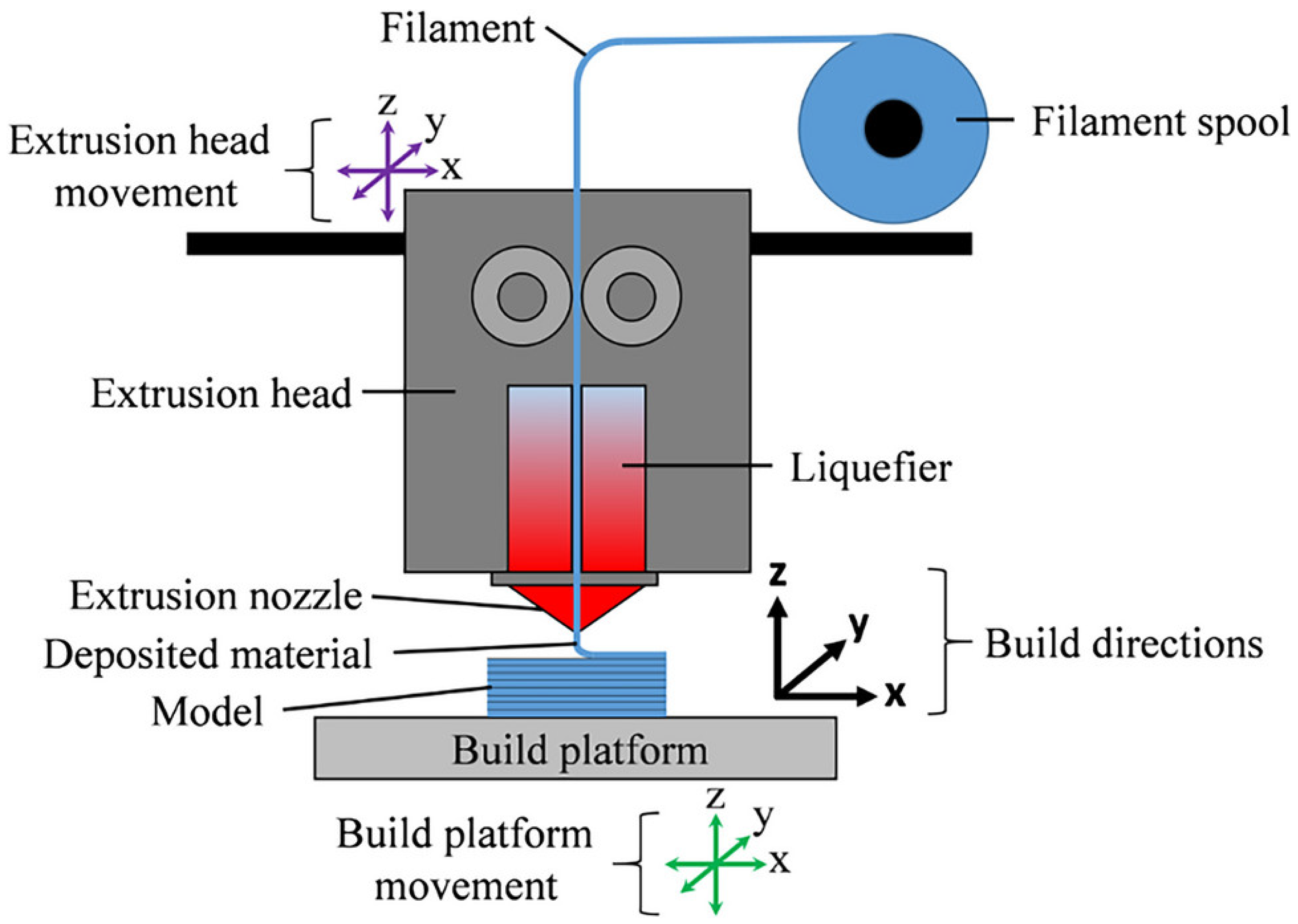









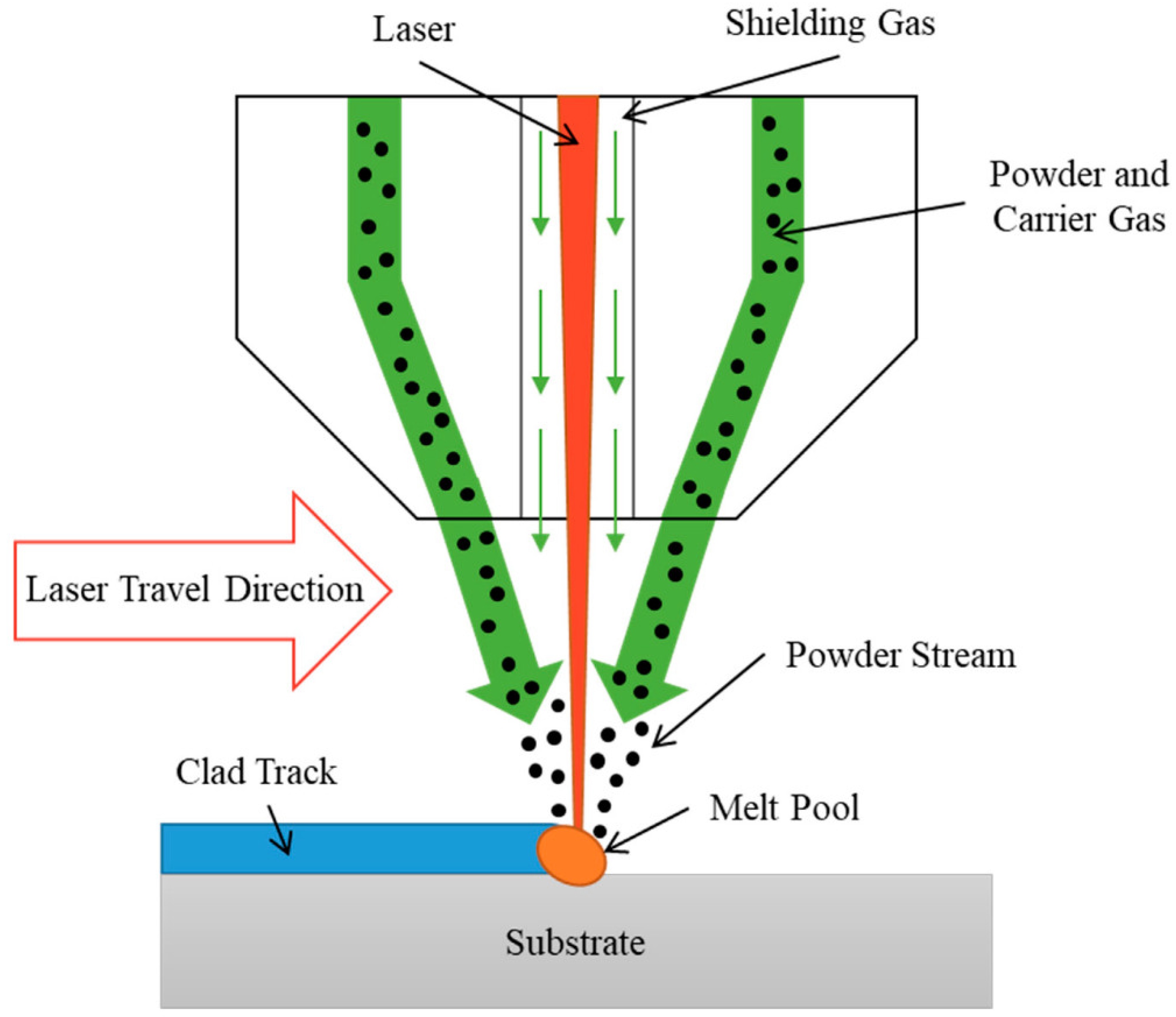

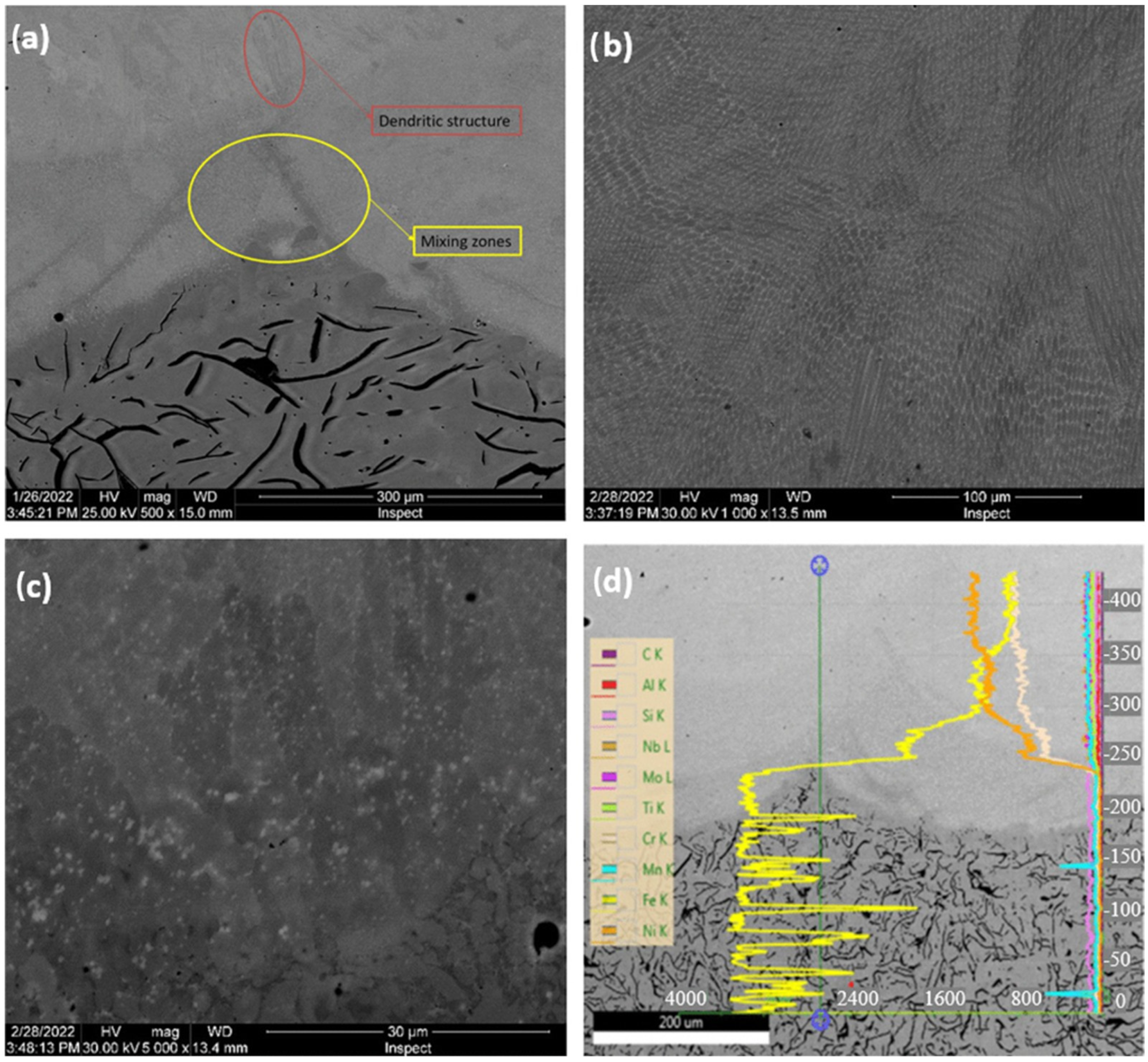

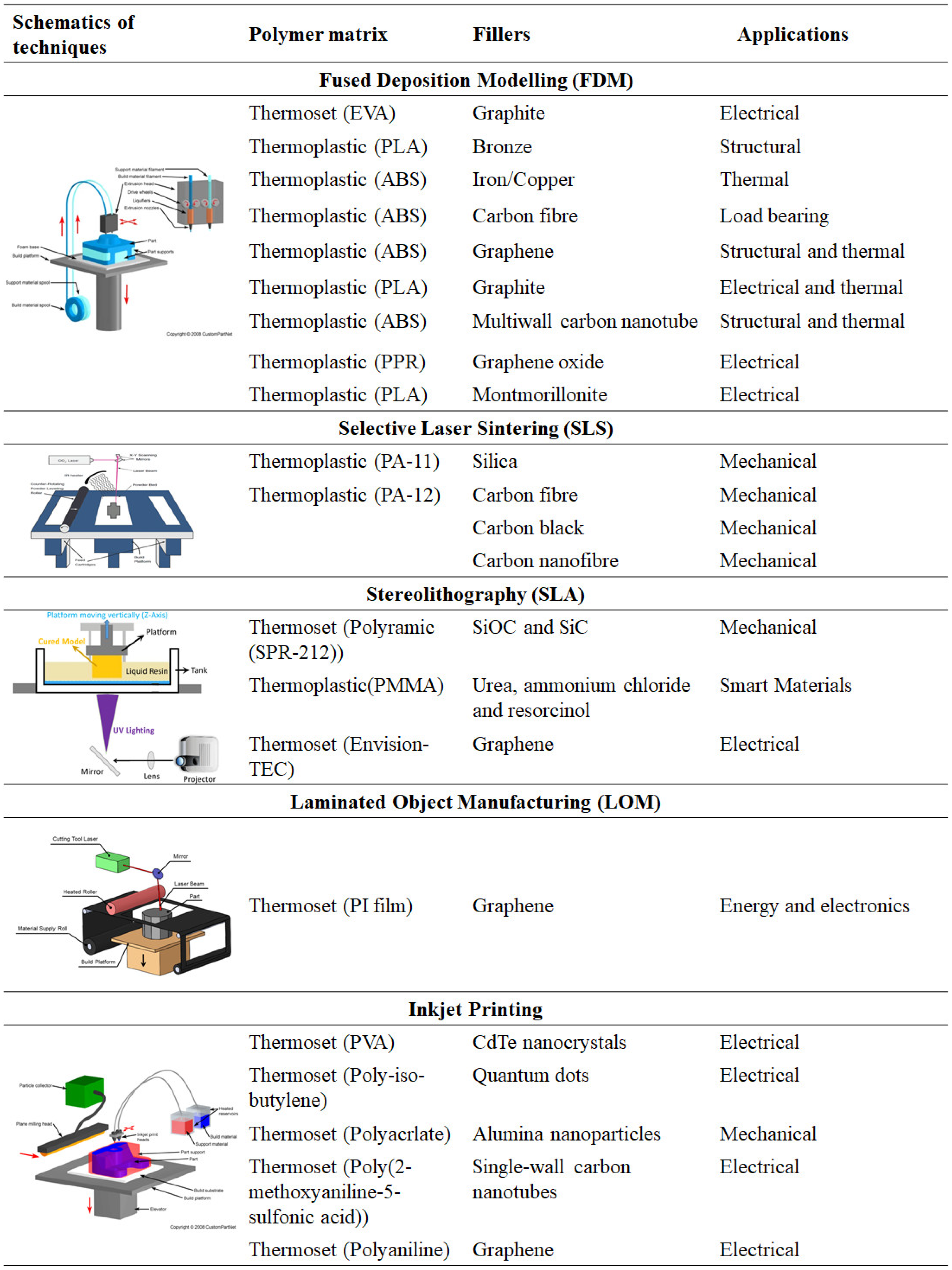
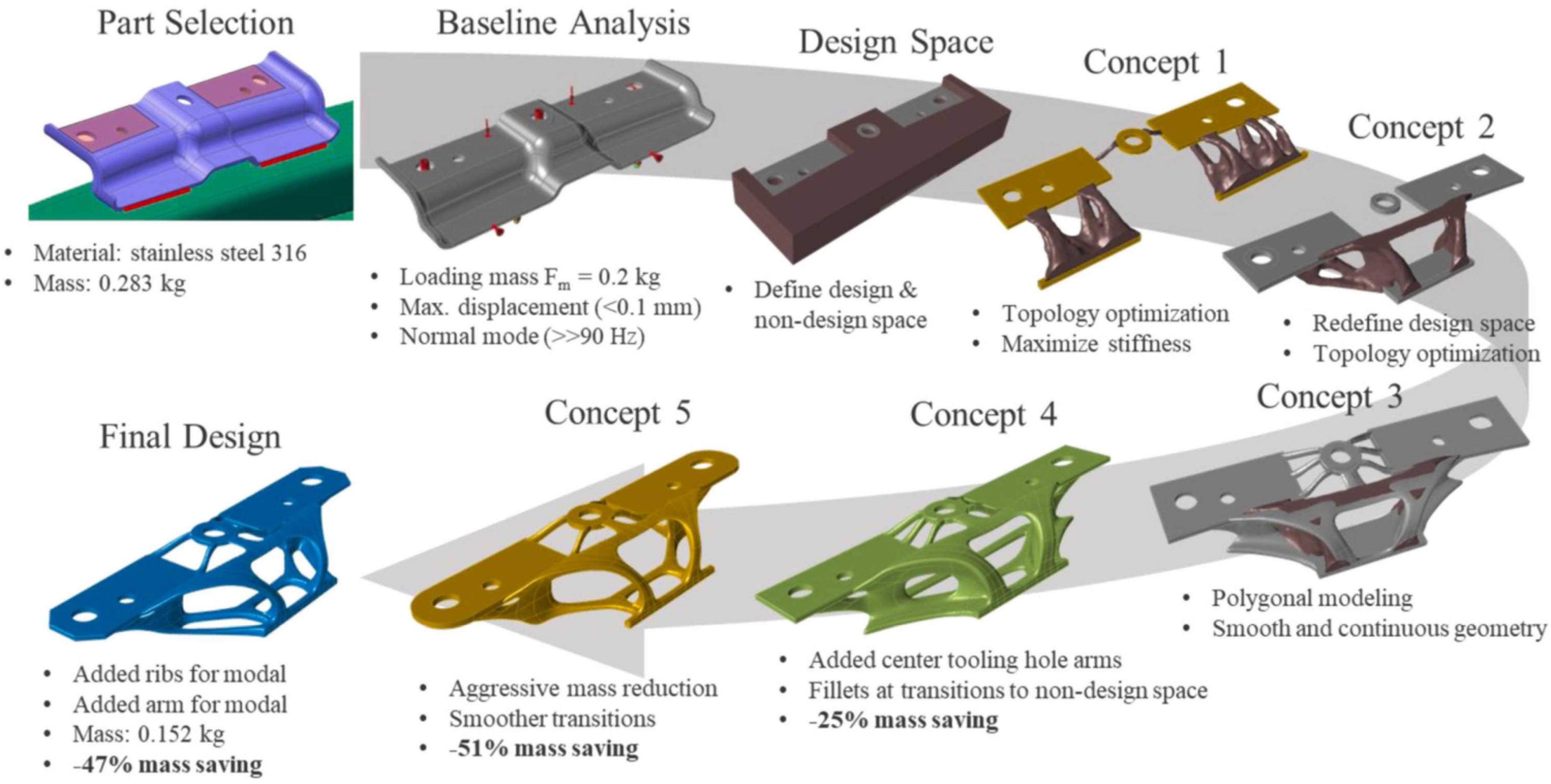
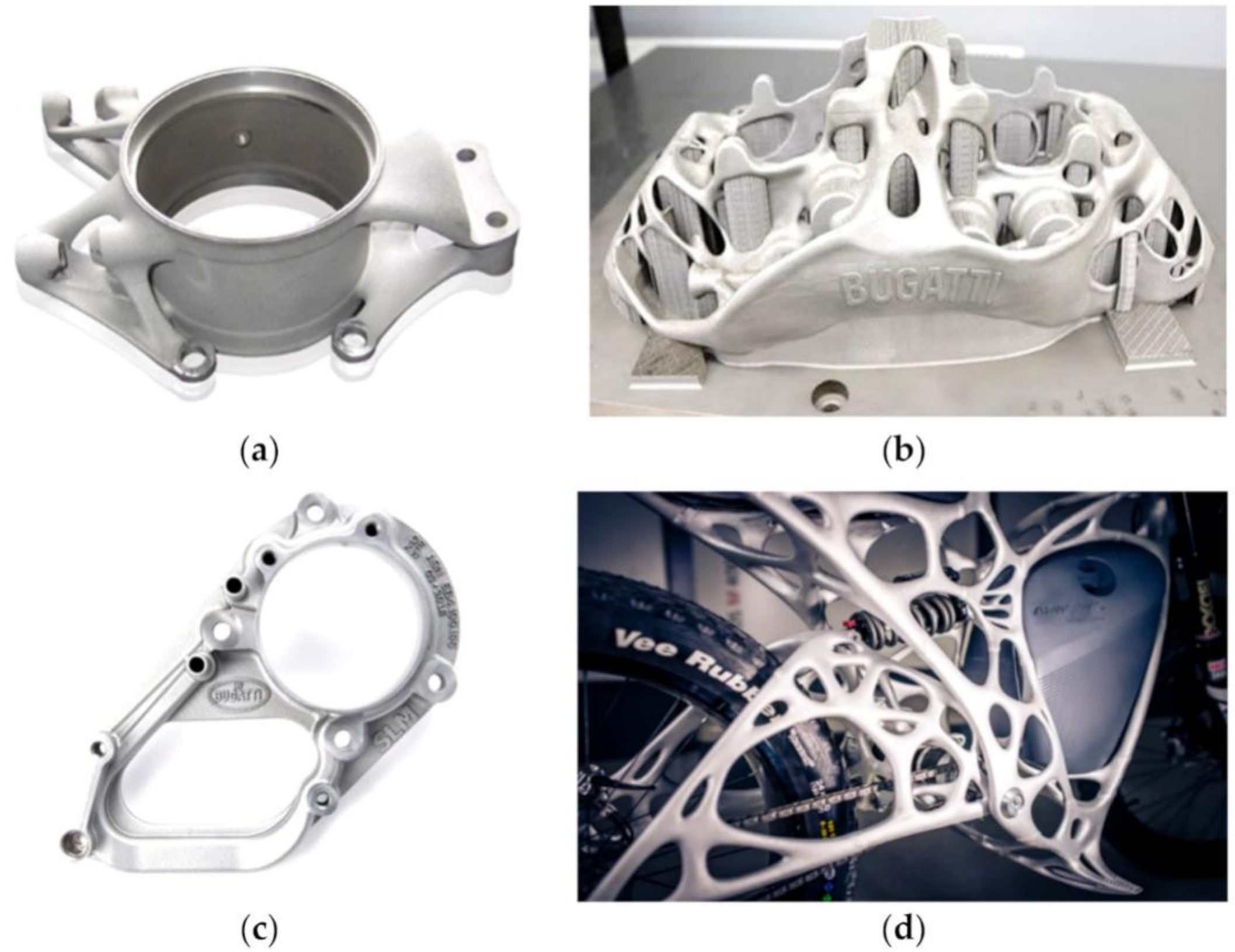

| Categories | Technologies | Power Source | Materials | Advantages | Disadvantages |
|---|---|---|---|---|---|
| Material extrusion | Fused deposition modeling | Thermal energy | Thermoplastics (ABS, PLA, PC, nylon) | Inexpensive, multimaterial, easy to operate | Poor resolution and surface finish, poor bonding |
| Vat photopolymerization | Stereolithography, digital light processing, continuous liquid interface production, daylight polymer printing | Ultraviolet light | Photosensitive resin, ceramics | High accuracy, good resolution, full automation | Overcuring lengthy post-processing, single composition, high cost of materials |
| Binder jetting | Binder jetting | Binder/thermal energy | Polymer/ceramic/metal powder | Wide material selection, relatively fast printing | Lengthy postprocessing, porosities within parts |
| Material jetting | Drop on demand, PolyJet, nanoparticle jetting | Thermal energy | Photopolymer resins, metals, ceramics | High accuracy, smooth surface finish, multimaterial | Low mechanical strength |
| Powder bed fusion | Direct metal laser sintering, electron beam melting, selective laser melting, selective laser sintering | Laser, electron beam | Polymer/ceramic/metal powder | High accuracy, high resolution, fully dense parts, high strength | Powder recycling, support structures, single material, residual stress |
| Sheet lamination | Laminated object manufacturing | Laser | Plastic/metal/ceramic foil | High surface finish | Material limitation |
| Directed energy deposition | Laser-engineered net shaping, direct metal deposition, laser metal deposition, laser cladding, laser consolidation | Laser | Metal/ceramic/powder | Repair of worn components, multimaterial (functionally graded materials) | Low accuracy, low surface finish, residual stress, requires postmachining |
| Company | AM Processes |
|---|---|
| BMW | Fused Deposition Modeling (FDM) (Davies, 2023) Selective Laser Sintering (SLS) (Ricoh 3D, 2020) Multi Jet Fusion (BMW Group, 2020) Laser Beam Melting (BMW Group, 2020) |
| Audi | Selective Laser Melting (SLM) (Petch, 2018) Stereolithography (SLA) (Krassenstein, 2015) Fused Deposition Modeling (FDM) (Krassenstein, 2015) Multi Jet Fusion (MJF) (Krassenstein, 2015) |
| Toyota | Selective Laser Sintering (SLS) (SAE International, 2021) Fused Deposition Modeling (FDM) (SAE International, 2021) Stereolithography (SLA) (SAE International, 2021) Multi Jet Modeling (MJM) (SAE International, 2021) Digital Light Processing (DLP) (SAE International, 2021) |
| Honda | Liquid Deposition Modeling (LDM) (Everett, 2021) |
| Ford | Selective Laser Sintering (SLS) (Ford Motor Company, n.d.) Stereolithography (SLA) (Ford Motor Company, n.d.) Fused Deposition Modeling (FDM) (Cune, 2018) Metal Binder Jet Printing (Molitch-Hou, 2021) |
| Volvo | Selective Laser Sintering (SLS) (Volvo Group, 2019) Fused Deposition Modeling (FDM) (Pearson, 2020) |
| Rolls-Royce | Electron Beam Melting (EBM) (Molitch-Hou, 2015) Selective Laser Melting (SLM) (Tyrrell, 2022) Directed Energy Deposition (DED) (Kingsbury, 2019) |
| Chevrolet | Selective Laser Sintering (SLS) (General Motors, 2020) Selective Laser Melting (SLM) (General Motors, 2020) Fused Deposition Modeling (FDM) (General Motors, 2020) |
| Nissan | Selective Laser Sintering (SLS) (General Motors, 2020) Selective Laser Melting (SLM) (General Motors, 2020) Fused Deposition Modeling (FDM) (General Motors, 2020) |
| Tesla | Sand Binder Jetting (Madeleine P., 2023) Fused Deposition Modeling (FDM) (3D printing.com, 2020) |
| Mercedes-Benz | Selective Laser Melting (SLM)(Additive News, 2017; Moore, 2020) Fused Deposition Modeling (FDM)(Moore, 2020) Stereolithography (SLA)(Moore, 2020) Selective Laser Melting (SLM) (Moore, 2020) |
| Volkswagen | Binder Jetting (Volkswagen AG, 2021) Fused Deposition Modeling (FDM) (Jackson, 2017) |
| Materials | Automobile Application | Advantages | Disadvantages |
|---|---|---|---|
| Polymers |
|
|
|
| Metals |
|
|
|
| Ceramics |
|
|
|
Disclaimer/Publisher’s Note: The statements, opinions and data contained in all publications are solely those of the individual author(s) and contributor(s) and not of MDPI and/or the editor(s). MDPI and/or the editor(s) disclaim responsibility for any injury to people or property resulting from any ideas, methods, instructions or products referred to in the content. |
© 2024 by the authors. Licensee MDPI, Basel, Switzerland. This article is an open access article distributed under the terms and conditions of the Creative Commons Attribution (CC BY) license (https://creativecommons.org/licenses/by/4.0/).
Share and Cite
Yang, J.; Li, B.; Liu, J.; Tu, Z.; Wu, X. Application of Additive Manufacturing in the Automobile Industry: A Mini Review. Processes 2024, 12, 1101. https://doi.org/10.3390/pr12061101
Yang J, Li B, Liu J, Tu Z, Wu X. Application of Additive Manufacturing in the Automobile Industry: A Mini Review. Processes. 2024; 12(6):1101. https://doi.org/10.3390/pr12061101
Chicago/Turabian StyleYang, Jian, Bo Li, Jian Liu, Zhantong Tu, and Xin Wu. 2024. "Application of Additive Manufacturing in the Automobile Industry: A Mini Review" Processes 12, no. 6: 1101. https://doi.org/10.3390/pr12061101






